A Preview of the Expedition's Discovery
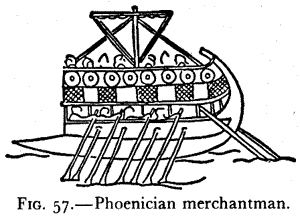 The image on the left is in the raw form, but reduced in size. The original size of this digital image is 1600 by 1200 pixels, allowing for close inspection of the surface detail. These photographs were taken in an area called Hickland. It featured some of the blackest and potentially oldest old Negev script. Sadly, much of the pecked shapes are already damaged by erosion and graffiti.
The tiny pits that cluster in the computer screen can be easily traced, revealing hidden detail. The image on the right (above) was adjusted in both brightness and contrast to enhance the appearance of the pecked rock surface. The sections were then traced and filled with white. 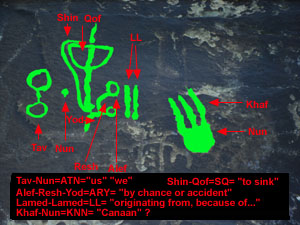 At first we expected to get an eroded image that would be primitive in construction. We were surprised when the enhanced image seemed to depict a ship being thrown against some sharp rocks! And this was more than coincidence. The rigging was still visible as thin etched lines and the ships skin was complete with planks. An additional image, taken at the same time, showed more details of the extreme left of this petroglyph, revealing the letters Tav and Nun or "we, us..."
The next group to the right of our ship's mast is a ligature which, reading from top to bottom, reads Alef, Resh, Yod or "by chance or accident..." The next double set of Lamed- Lamed is "on account of... originating from... because..." and the final symbol, which looks like an animal's claws, is interpreted to be a place name of khaf- Nun (repeated) or KNN= "Canaan..." Our translation, done here with the translation program, is only an approximation of the meaning. We would suggest that, at first glance, we have, We sank by accident, originating from Canaan. Much of the remaining petroglyph detail was faded and could not be discerned from the erosion. We did not consider these areas in our translation. As usual, we welcome your comments. We will continue to share the images as they are reviewed. Our translations are not concise. They are intended only as possibilities, based on our knowledge of the regional use of old Negev and the currently available data. We encourage and welcome scrutiny of this work and other possible interpretations.
Gary Vey, Editor
|
.
.
.
.
.
.
.
.
.
.
.
.
If you have a suggestion or history related article to submit, send it to:
Editor/viewzone.com
myristicin@hotmail.com
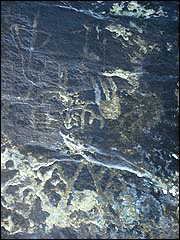
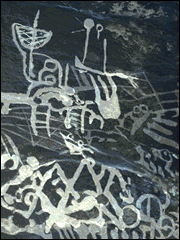
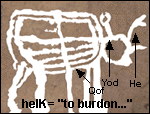 Taking another look at the rendering we noticed that letters could be distinguished in this extremely clever ligature. The ship's mast is actually a variant of Qof. This is also a shape encountered on the long mural in
Taking another look at the rendering we noticed that letters could be distinguished in this extremely clever ligature. The ship's mast is actually a variant of Qof. This is also a shape encountered on the long mural in